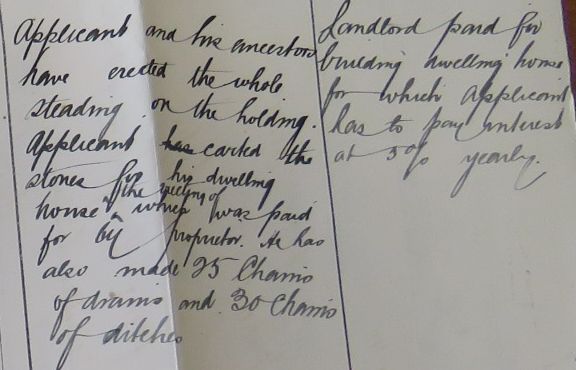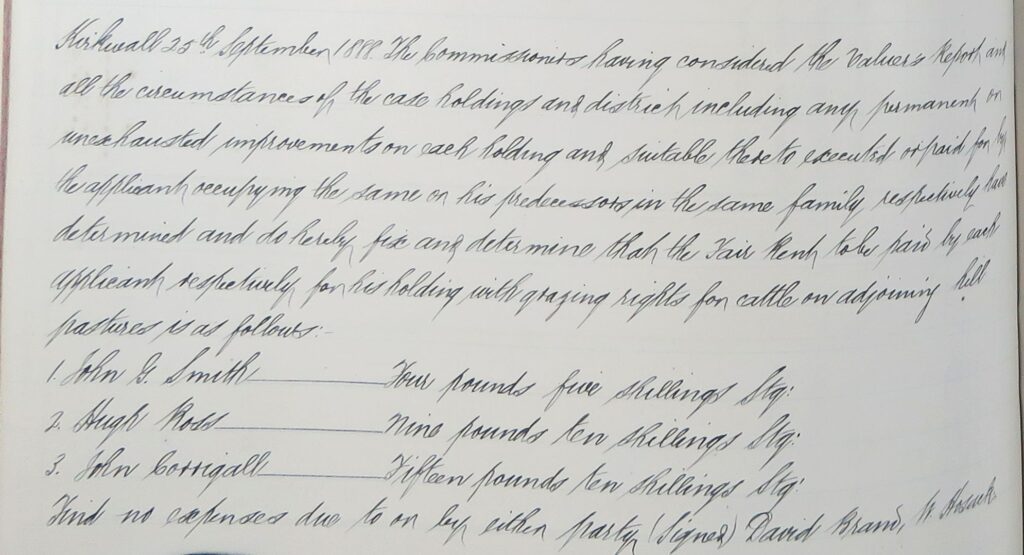Were your ancestors crofters? That is, living in one of the seven crofting counties of Scotland – Shetland, Orkney, Caithness, Sutherland, Ross and Cromarty, Inverness-shire and Argyll – with a holding of not more than £30 in annual value or rent. If the answer is yes and they were there from 1886 onwards there’s a good chance they applied to the Crofters’ Commission for a rent reduction and maybe reduction or cancellation or arrears too. You will find some background on the Crofters’ Commission in this blog that I wrote some years ago.
Crofters’ Commission records for each county have three main parts: Applications, Landholders Holding Books and Court Rolls. They are not the easiest records to access but do give a unique insight into the lives of crofting ancestors. (Newspapers may be an alternative source of information on this topic.)
1 – Applications
These are papers from each case with summary details of the application and the outcome. They can include:
- Name of the estate, its owner and his agent
- Name of the crofter
- Name of the lands
- Estimated area of arable land and of outrun
- Common pasture (if any)
- Stock the crofter was entitled to keep
- Annual rent
- Services or other payments in lieu of rent
- Arrears
- Permanent or unexhausted improvements made by the crofter or his family
- Permanent or unexhausted improvements by the Landlord or his predecessors
Compensation for improvements
Improvements carried out by crofters were a key issue. The right to expect compensation for permanent improvements they had made which would benefit the next tenant (who gained a better croft) and the landlord (who could thus get a higher rent) was central. Ditching and draining to improve the land along with the construction of better buildings, house and/or steading, were the most common. (The croft is technically the land; it is not the house.)
Here are the improvements at Afrigate, Brims, Orkney, carried out by James Nicolson (col 1) his landlord JGM Heddle of Melsetter (col 2) and their predecessors.

Transcription: (Col1) Applicant and his ancestors have erected the whole steading on the holding. Applicant carted the stones for his dwelling house, the erecting of which was paid for by proprietor. He has also made 25 Chains of drains and 30 Chains of ditches. (Col 2 ) Landlord paid for building dwelling house for which applicant has to pay interest at 5% yearly. [A chain is 22 yards or 20.117 metres]
The same document set also recorded the subsequent administrative and other steps in the process of rent review including: notification to landlord, appointment of valuer; date of visit to the holding by Crofting Commissioner and valuer; Crofting Commissioners’ decision. In James Nicolson’s case, the whole process from receipt of his application to decision was almost a year. His rent went down from £15.14.0 to £11.5.0 per year.
2 – Landholders’ Holdings Books
Also known as Crofters’ Holding Books, they record the court’s decisions. Quite a lot of information is repeated from the applications. Each volume has an index at the back. Here is an excerpt from the result of an application made by three crofters including my great great grandfather Hugh Ross.

Transcription: Kirkwall 25th September 1888 The Commissioners having considered the Valuer’s Report and all the circumstances of the case holdings and district including any permanent or unexhausted improvements on each holding and suitable thereto executed or paid for by the applicants occupying the same or his predecessors in the same family respectively have determined and do hereby fix and determine that the fair Rent to be paid by each applicant respectively for his holding with grazing rights for cattle on adjoining hill pastures is as follows: 1. John G Smith Four pounds five shillings Stg [sterling] 2. Hugh Ross nine pounds ten shillings Stg 3. John Corrigall fifteen pounds ten shillings Stg Find no expenses due to or by either party (Signed) David Brand, W Hosack.
3 – Court rolls
These are the indexes to the records. They are held by the Scottish Land Court rather than the National Records of Scotland (NRS) but they have been imaged and are on Virtual Volumes in the Historical Search room at the NRS in Edinburgh. I would advise looking for your ancestor’s name in the first available volume as there was a large number of applications in the early years of the Crofters’ Commission. Subsequent applications could be made after seven years.
Where are the records and how do you access them?
They are mainly held by the National Records of Scotland (NRS) in the Scottish Land Court series, LC. The sections of most interest will be LC2-LC53 – the records for each county. Records relating to Orkney are all in LC23, while Ross & Cromarty is LC27, for example.
Each county’s records are divided into the three main parts described above so
- LC23/1 – applications from Orkney crofters
- LC23/2 – court decisions (landholders holdings) for Orkney
- LC23/3 – court rolls for Orkney. These act as your index and are searchable on Virtual Volumes at the NRS.
LC23/4 – miscellaneous items for Orkney – may be of interest too. Other counties are arranged in the same way.
LC1 (the Crofters Commission (later Scottish Land Court) annual reports) is worth a check too. Read more in the NRS catalogue. In 1912 the Scottish Land Court superseded the Crofters’ Commission and the main provisions of the Crofting Act extended to the whole of Scotland.
Newspapers
If you are fortunate enough to have Orkney crofter ancestors, then you will find a lot of information in the local newspapers, some of it verbatim from the Crofters’ Commission hearings and full of colour. For example, when James Nicolson, my great grandfather, applied for a rent reduction for the fourth time in 1922, on the basis of crops lost to sea-gust, he was asked what else he did. “What else would you expect a man of seventy-five years of age to do?”, was his reply. He also stated that his family had been in the croft for 250 years.1The Orkney Herald, 26 July 1922, In possession for 250 years, p 5 col 2. British Newspaper Archive per FindMyPast. Unfortunately on this occasion the outcome was not recorded by the newspaper. but I have a date that I can check in the Applications (LC23/1) or Landholders’ Holdings Books (LC23/2).
For more from the newspapers see The Orkney Crofters (pdf) with excerpts from the book of that title which is a compilation of reports from the first visit of the Crofters’ Commission to Orkney. I have not so far found a similar book for any of the other counties though newspapers including the Ross-shire Journal did carry some reports.
A post inspired by the Society for One-Place Studies blog prompt #OnePlaceSources

